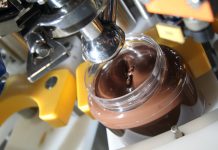Mixing and refining are a guarantee in order to obtain the correct feeling of mass consistency and “smoothness & taste” of the finished product
Chocolate processing can be divided in two basic steps: preparation of ingredients, i.e. the production of cocoa mass (cocoa liquor) and cocoa butter, crucial for the production of chocolate and the use of the ingredients. The second step on its turn can be divided in three operations: mixing or blending, refining and conching. For convenience and better understanding, the first two operations will be dealt together. In production processes all individual operations play a more or less important role; this “rule” perfectly applies also to the processing of chocolate and similar substances. In the specific case, mixing and refining are a guarantee in order to obtain the correct feeling of mass consistency and “smoothness & taste” of the finished product. There are various mixer models; for simpler understanding, here only the two most typical “historical” types are described: One is based on the rotary movement of a horizontal surface under two heavy “spring-mounted” rollers, the  traditional press; the other one is based on the movement of a spiral stirrer or mixing arms. Both types of mixers generate heat, which must be appropriately controlled so as not to jeopardize the quality of Chocolate. In fact, since chocolate contains milk, the temperature shall not exceed 40°C, to prevent the degeneration of milk proteins, whereas for bitter chocolates the temperature can reach up to 70-80°C (50-55°C on average). Particularly effective are vacuum mixers, although infrequently used nowadays, which in just a few hours provide an almost complete removal of humidity and volatile acids that are still present. Experience shows that a good mixer provides for perfect blending of the ingredients as well as for considerable savings in working hours in the most expensive phase of this process: conching. In the past, for so-called “common chocolate”, the production process could be stopped at this point – as it still occurs especially in South America for the production of the “Chocolate de Tazza”. It is a good habit to start mixing by introducing into the equipment the liquids first (melted cocoa mass and, eventually, part of the melted cocoa butter) and then the solids (sugar, powder milk, etc.).
traditional press; the other one is based on the movement of a spiral stirrer or mixing arms. Both types of mixers generate heat, which must be appropriately controlled so as not to jeopardize the quality of Chocolate. In fact, since chocolate contains milk, the temperature shall not exceed 40°C, to prevent the degeneration of milk proteins, whereas for bitter chocolates the temperature can reach up to 70-80°C (50-55°C on average). Particularly effective are vacuum mixers, although infrequently used nowadays, which in just a few hours provide an almost complete removal of humidity and volatile acids that are still present. Experience shows that a good mixer provides for perfect blending of the ingredients as well as for considerable savings in working hours in the most expensive phase of this process: conching. In the past, for so-called “common chocolate”, the production process could be stopped at this point – as it still occurs especially in South America for the production of the “Chocolate de Tazza”. It is a good habit to start mixing by introducing into the equipment the liquids first (melted cocoa mass and, eventually, part of the melted cocoa butter) and then the solids (sugar, powder milk, etc.).
The game is worth the candle
Usually cocoa butter is added in the conching phase, since the refining by means of cylinders limits the quantity of fat present in the mass. The mixing time is variable, depending from type of ingredients and capacity of the equipment used; however, 30 minutes can be considered an appropriate time for a good blending. The suitably mixed mass is then transferred to the refining process by means of a screw feed. When using crystal sugar, the first step of this operation is called pre-refining. The pre-refining machine used to this purpose features 2 or 3 water-cooled rollers of different lengths and diameters. The scope of this operation is of reducing the size of the particles, especially sugar ones, in order to obtain a mass with a particle size between 80 and 120 micron(crystal sugar particles can measure between 400 micron up to more than 1,000 micron). Among other things, this first refining operation will enhance the capacity of solid Ingredients to adsorb





This topic is equipped with full of knowledge. Many many thanks to that person who had shared his knowledge. This person is having very good knowledge of chocolate process. Hats off to you sir.
Comments are closed.